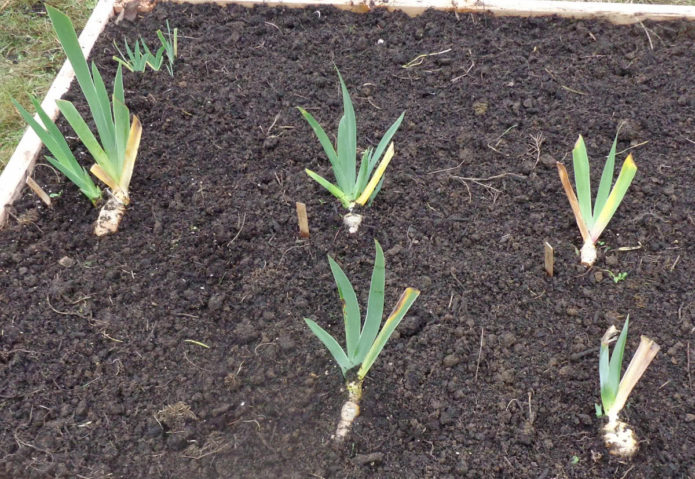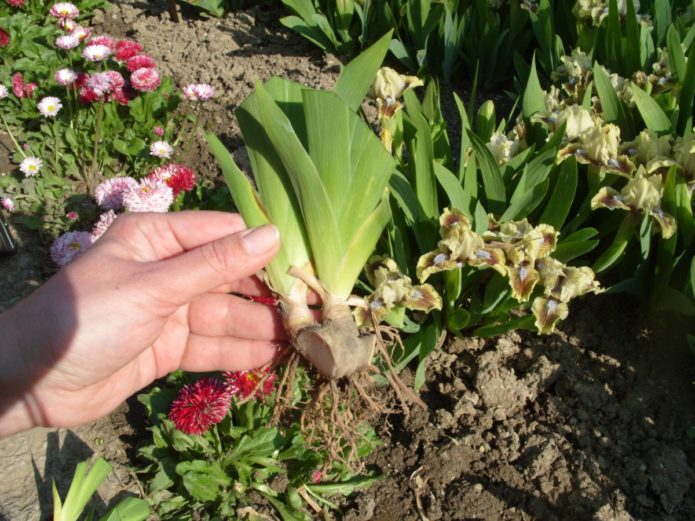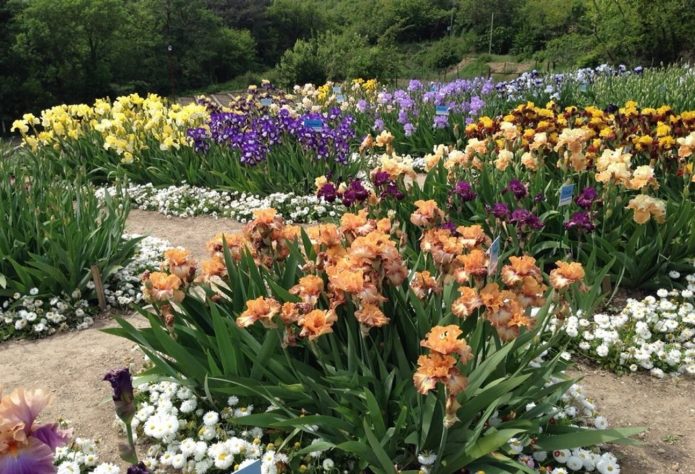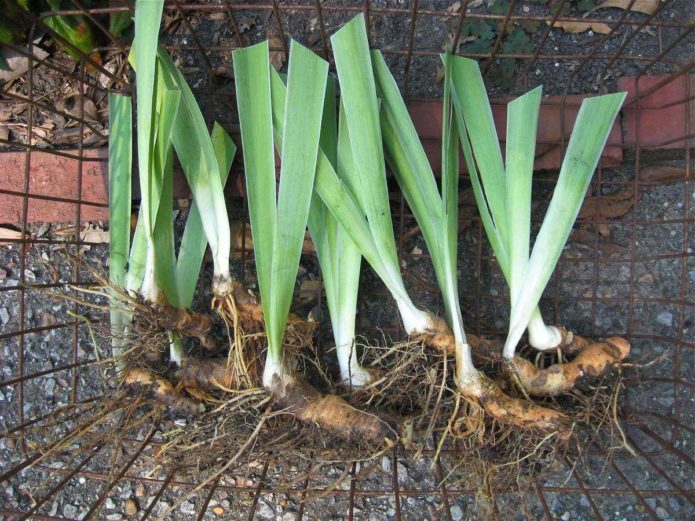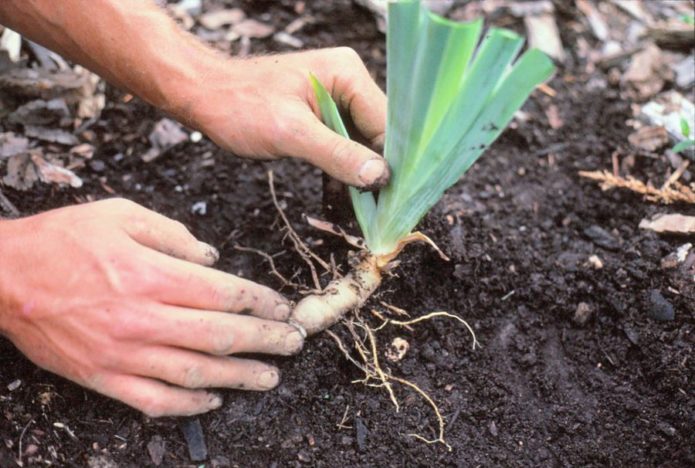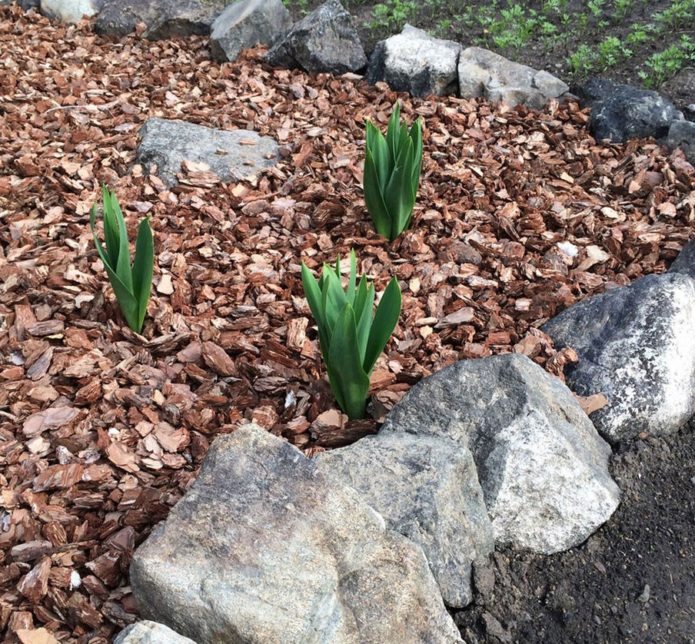Irises are one of the few crops that can be planted during any warm season. With a correctly performed procedure, the plant quickly takes root and begins to develop. However, the best adaptation occurs when planting irises in the fall. If you carry out the procedure some time before the onset of frost in compliance with agrotechnical requirements, you can expect the flowering of the culture as early as next season.
When is the best time to plant irises: autumn or spring
Experienced gardeners prefer to plant irises in late summer and early autumn. At this time, the plant enters a dormant phase and stops growing, gaining strength for lush flowering in the next season. The next stage of cultural development begins closer to mid-October. During this period, irises are preparing for wintering, sap flow begins in the rhizome. If you divide the plant at this time and plant it in separate holes, rooting will take place quickly and new buds will begin to form.
Transplanting in the spring is also permissible and rooting is no less successful, but in this case, flowering may not occur in the current season: the buds of the plant do not have time to mature before the onset of cold weather. An additional risk of spring planting in regions with a temperate climate is the risk of recurrent frosts and heavy precipitation. A poorly rooted plant may not withstand these tests, so planting in the spring is recommended exclusively in the southern regions.
Disembarkation dates
The specific dates of planting are chosen based on the climatic conditions of the region and weather conditions. After being placed in the ground, the iris needs 1.5 months for successful rooting. If you are late, the sudden onset of freezing temperatures can kill the plant or lead to partial decay of the roots in winter.
Recommended landing dates by region:
| Region | Recommended timing |
| South | Mid to late October |
| Middle lane and Moscow region | Mid to late September |
| Leningrad region | First half of August |
| Siberia and the Urals | End of July - first decade of August |
Lunar calendar dates:
- September 2-4, 11-12, 15-17;
- 1, 4-6, 12-14, 19-21 October.
How to choose a place and prepare it for planting
Irises grow well both in the sun and in partial shade. The only contraindication is planting under tall trees and bushes. For successful development, the sun is necessary not only for the leaves, but also for the roots of irises, since flower buds will not form on them in full shade.
The site for planting should be located at some elevation, since most flower varieties do not tolerate waterlogging of the roots. Only smooth, bristly and marsh species like the increased water content in the soil. Most iris varieties are drought-resistant, so they can be harmed by the proximity of groundwater. If the moisture is at a height of less than 1.5 m, a drainage layer is laid on the site before planting flowers.
Flowers are planted in beds 15–20 cm high. They are prepared 1–2 weeks before the intended planting so that the soil settles and compresses. When digging from the soil, carefully select all the weeds and pieces of their roots. If the grass grows in the curtain of irises, it will be almost impossible to remove it without harming the roots.
The plant prefers slightly acidic loams. Heavy soils are loosened with sand, too light - with clay. To increase fertility, the following is added to the soil per square meter:
- 2 buckets of humus,
- 40 g of superphosphate;
- 15 g of potassium salt;
- 150 g of wood ash.
Important! Nitrogen fertilizers are not applied to the soil during autumn planting, since they will cause active vegetation and prevent irises from preparing for wintering.
How to choose planting material
For complete confidence in the variety, it is recommended to buy an iris seedling in a flowering state. However, such specimens do not take root well and leave stress for a long time. When choosing, you should give preference to copies with the following characteristics:
- strong main stem;
- at least 2 additional baby sprouts;
- light, not overdried, developed roots without signs of disease.
Reference! In seedlings with one sprout, flowering occurs only after 2 seasons, since next year the iris will develop roots and form shoots.
Planting instructions with photo and video
The planting process consists of the following steps:
- The roots of the seedling are soaked in a weak solution of potassium permanganate or the preparation "Maxim Dachnik" for 20-30 minutes. The leaves are cut in the shape of a house, leaving a center height of about 20 cm.The roots are shortened to 10 cm.
- A hole 15 cm high is dug on a prepared bed. The distance between plants is 30–40 cm. To prevent the development of root rot, the hole is watered with a fungicide solution (Hom, Fundazol, Fitosporin).
- A layer of sand or small pebbles is laid at the bottom of the hole as drainage. A low hill of soil is poured in the center and a seedling is placed on it, spreading the roots along the slopes to prevent them from bending.
- The hole is filled with earth, tamping each layer. The root collar is placed above the soil surface, the leaves are directed strictly vertically. In a properly planted iris, part of the rhizome should be visible above the surface, since it needs sunlight to form the shoots correctly.
- The plant is watered, spending 1 liter of water per bush.
Important! Too deep planting of iris will lead to decay of the rhizome and death of the plant.
For Dutch and bearded irises have their own nuances of planting.
What kind of care to ensure that the planting successfully overwinters in the open field
After planting, the area with irises is mulched with peat, sawdust or soil with a layer height of 10 cm: this will prevent the freezing of flower buds in winter. If the weather is hot, dry, the plants are watered every 15 days, preventing the soil from washing out.
In regions with severe winters or in snowless winters, the rhizomes are additionally covered with straw or foliage. The shelter is performed not earlier than the onset of stable frosts, otherwise the plants will begin to rot. After the snow melts, the roots are freed from the shelter.
With the right choice of place and adherence to the planting technology, young irises of many varieties will delight with flowering already next season. Some varieties will form buds only after a year.
